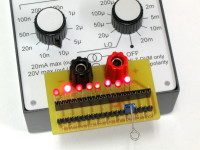LED sorting accessory [140067-I]

(from henrip4)Adjustable DC current source (130287-I) revisitedThis simple tool can help to sort or select through-hole LEDs, by visually comparing their colour, brightness and/or radiation angle.
(from henrip4)
Adjustable DC current source (130287-I) revisited
This simple tool can help to sort or select through-hole LEDs, by visually comparing their colour, brightness and/or radiation angle.
Although they all may look exactly the same when they're lying in your storage box, LEDs can look completely different when lit, especially when mounted close to each other (like in an LED bar or panel).
In the "early LED days" this even was the case with LEDs from the same manufacturer, and even from the same type and production run. Production processes may have improved, but I think most of us have one box marked 'LEDs' which contains devices of undetermined brand and type numbers. With this accessory LEDs can easily be connected in series by inserting them in a socket strip, the current source can be set to different values to see what the light bar looks like. Even small differences in color, brightness and radiation angle can be spotted immediately.
With our adjustable DC current source the maximum clamping voltage is about 20V, which means that we can supply up to (+/-) 10 ‘normal’ LEDs in series. This number depends on the type and color, a red one will typically have a forward voltage of approx. 1.8V, whereas blue may be in the 3V region.
Set the clamping voltage of the DC current source to maximum value (fully clockwise), the current in the 1mA..20mA range. Start with the first LED in the left-most socket position, with the cathode pointing to the left, and insert the other ones in neighbouring positions to the right. A jumper must be set on the two pins in the same position in front of the rightmost LED. All LEDs should be lit then, the reading on the LCD of the current source showing the total forward voltage of all the LEDs in series. You can switch off one or more LEDs by moving the jumper, this way you can also determine the forward voltage of all individual LEDs by subtracting the corresponding readings on the display.
If the clamping indicator on the front panel of the DC current source lights, the forward voltage of the LED chain exceeds the range of our DC current source (we did set the clamping to max, right?).
.



Discussion (0 comments)